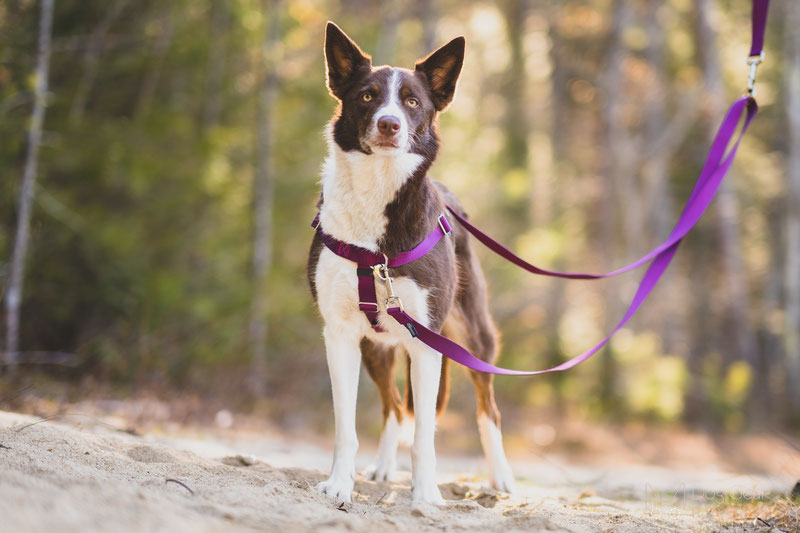Pets
Dual-Handle Dog Harness And Leash Sets: Extra Control For Training And Walks

Ever felt like your dog is walking you instead of the other way around? You clip the lead on, step outside, and boom, your dog spots a bird, another dog, or a leaf blowing in the wind, and suddenly it is a full-body tug-of-war. Sound familiar? Whether you have a puppy still learning the ropes or a strong adult dog who likes to charge ahead, getting full control during walks can be tricky.
That is where a good dog harness and leash set with dual handles changes everything. It is not just about keeping your dog close. It is about keeping them safe, helping them focus, and making your walk feel like something you actually enjoy.
Let us look at how this simple upgrade can make a huge difference in your everyday routine.
Why Do Some Walks Feel More Like A Struggle?
No one expects walking the dog to feel like a workout. But for many people, especially with medium or large dogs, that is exactly what it becomes. One sharp lunge at a squirrel, and your shoulder feels it all day.
Most of this comes down to control, or the lack of it. Basic leads only give you one point of grip, and if your dog is pulling, turning, or suddenly reacting, it is not enough. And if your dog gets overexcited or nervous around traffic or strangers, you need a fast way to keep them grounded.
This is where a dog harness and leash set designed for control can really help. Especially the ones that come with dual handles, built right into the lead.
What Makes A Dual-Handle Dog Harness And Leash Set Different?
Not all harnesses and leads are created equal. A high-quality dog harness and leash set with two handles offers you both flexibility and backup in moments when you need it most.
Here is why it matters:
-
Two Handles, Two Purposes
The standard handle at the end of the lead gives your dog room to roam. Perfect for relaxed walks or sniff breaks. The second handle, placed closer to the dog, lets you take quick control when needed. It is ideal for:
- Busy pavements or crowded parks
- Passing other dogs or cyclists
- Crosswalks and street corners
- Sudden distractions or triggers
It is like having a “zoom-in” button for your dog. No need to wrap the lead around your hand or shorten it manually. Just grab the second handle, and you are good.
-
Harness Support Adds Comfort
The harness part of a dog harness and leash set spreads pressure across the chest instead of pulling at the neck. This is especially important for dogs that pull or for small breeds that are more sensitive to pressure.
With the right fit, your dog moves naturally, breathes freely, and feels more relaxed. And when your dog is calm, the whole walk gets easier. For Pet Sake Pet Sitting & Dog Walking provies dog sitting Charlotte.
-
Better For Training
Teaching a dog to walk nicely on a lead is not always easy. But a dog harness and leash set helps reinforce good behaviour by giving you better control and clearer feedback.
When your dog pulls, the harness gently redirects them. When they walk by your side, the lead stays loose. That instant connection helps them learn faster and helps you stay calm.
-
Real Life, Real Benefits
Let us say you are out with your young Labrador. She sees another dog across the street and lunges. You are holding the end of the lead, but by the time you react, she is halfway into the road. Scary, right?
Now imagine the same walk with a dual-handle dog harness and leash set. As soon as you see her ears perk up, you instinctively move your hand to the second handle. You gently guide her closer, keeping her calm and secure by your side. No panic, no drama, no danger.
Things To Look For In A Dog Harness And Leash Set
Choosing the right dog harness and leash set makes a real difference. Here are a few features to check before you buy:
- Padded handles: Your hands will thank you during longer walks.
- Adjustable fit: Especially for harnesses, your dog should feel snug but not squeezed.
- Strong clips and stitching: You want gear that holds up to real life, not just looks good.
- Reflective trim: A small detail that adds big safety during evening walks.
- Breathable materials: No one wants their dog overheating in the sun.
Conclusion
Walking your dog should not feel like a chore or a challenge. A quality dog harness and leash set with dual handles gives you the kind of control that makes walks easier, safer, and more enjoyable for both of you.
Whether you are working on training or just want peace of mind in busy areas, this small upgrade can make a huge difference in your day-to-day routine. Look for a reliable, well-made dog harness and leash set, and get back to loving your walks together.
Pets
Bear-wise practices togwotee pass: Your Safety Guide

Introduction
Nestled in the heart of Wyoming’s wilderness, Togwotee Pass stands as one of America’s most spectacular mountain corridors. This high-elevation gateway connects Jackson Hole to the Wind River Valley, offering breathtaking views of the Teton Range and access to some of the region’s most pristine backcountry. However, this rugged beauty comes with responsibility you’re entering prime habitat for both black bears and grizzly bears.
The Continental Divide ecosystem surrounding bear-wise practice Togwotee Pass supports healthy bear populations, making proper bear safety practices essential for every visitor. Whether you’re planning a day hike, multi-day backpacking trip, or car camping adventure, understanding how to coexist safely with these magnificent animals protects both you and the bears themselves.
Bears that become habituated to human food sources often become aggressive and may need to be relocated or destroyed. By following bear-wise practices, you’re not just ensuring your safety you’re helping preserve these incredible creatures for future generations. This guide will equip you with everything you need to know about staying safe in bear country around Togwotee Pass.
Understanding Bear Behavior in the Togwotee Area
The forests and meadows around Togwotee Pass provide ideal habitat for both black bears and grizzly bears. Black bears are more common and generally smaller, while grizzlies are larger, more aggressive, and distinguished by their shoulder hump and dished face profile.
Bears are naturally omnivorous and spend most of their waking hours searching for food. In the Togwotee region, they feed on berries, roots, insects, fish, and occasionally larger mammals. Their incredible sense of smell seven times stronger than a bloodhound’s can detect food from miles away.
Most bear encounters occur because bears are investigating food odors. They’re naturally curious but typically avoid humans when given the chance. However, mother bears with cubs are extremely protective and should be given wide berth. Similarly, bears defending a food source or surprised at close range may react defensively.
Understanding seasonal patterns helps predict bear activity. Spring brings bears out of hibernation, hungry and searching for food. Summer sees increased activity as bears build fat reserves, while fall triggers hyperphagia—a feeding frenzy before winter hibernation. During berry season (late summer), bears are particularly focused on foraging and may be less aware of their surroundings.
Safe Food Storage: Protecting Your Provisions
Proper food storage is your most critical bear safety practice in the Togwotee area. All scented items—including food, toiletries, garbage, and cooking equipment must be stored in bear-proof containers or hung at least 12 feet high and 4 feet from tree trunks.
Bear canisters offer the most reliable protection. These hard-sided containers are designed to withstand bear attempts at opening and should be placed at least 100 yards from your sleeping area. Popular models like the BearVault or Garcia containers provide adequate storage for most trips.
If bear canisters aren’t available, use the traditional hang method. Tie a rope over a sturdy branch at least 12 feet high, suspending your food bag 4 feet from the trunk and 8 feet below the branch. This technique requires practice and suitable trees, which aren’t always available in the high-elevation areas around Togwotee Pass.
Never store food in your tent or vehicle. Bears can easily break into cars and RVs, causing expensive damage while creating dangerous situations. Even seemingly innocent items like toothpaste, deodorant, and scented lip balm must be stored with your food.
Cook and eat at least 100 yards from your sleeping area when possible. This separation prevents food odors from concentrating near your tent. Use a portable camp stove rather than building fires, which can spread food smells through smoke.
Proper Waste Disposal in Bear Country
Waste management is equally important as food storage for bear safety. Pack out all garbage, including food scraps, wrappers, and organic waste. Bears investigate any unusual scent, and even apple cores or orange peels can attract them to camping areas.
Strain dishwater to remove all food particles, then scatter the gray water at least 200 feet from camp and water sources. Pack out the food particles with your other garbage. Never dump dishwater near your tent or cooking area.
Human waste requires special consideration in bear country. Use established outhouses when available. For backcountry camping, dig cat holes 6-8 inches deep and at least 200 feet from water sources, trails, and campsites. Don’t bury toilet paper—pack it out to prevent bears from digging up waste sites.
Feminine hygiene products should be packed out rather than buried, as bears may be attracted to the scent. Store these items with your food in bear-proof containers.
Consider using unscented toiletries and biodegradable soap to minimize attractive odors. Even sunscreen and insect repellent can attract curious bears, so store these products properly.
Hiking and Camping Safety Tips
Making noise while hiking is your best defense against surprising bears. Talk loudly, clap your hands, or use bear bells, especially near streams, dense vegetation, or blind corners where visibility is limited. The goal is to announce your presence and give bears opportunity to avoid you.
Travel in groups when possible. Bears are less likely to approach larger groups, and multiple people can better spot potential problems. Keep children close and never allow them to run ahead on trails.
Be extra cautious around natural food sources. Berry patches, fish streams, and animal carcasses attract bears. If you encounter a carcass, leave the area immediately and report it to local authorities.
Choose campsites carefully in the Togwotee area. Avoid camping near streams where bears fish, berry patches, or areas with obvious bear sign like tracks, scat, or claw marks on trees. Look for sites with good visibility and multiple escape routes.
Set up your camp in a triangular pattern: sleeping area, cooking area, and food storage should be at least 100 yards apart from each other. This prevents bears attracted to food odors from investigating your sleeping area.
Keep flashlights and bear spray easily accessible throughout the night. If you hear something outside your tent, make noise before investigating. Most bears will leave if they know humans are present.
Emergency Procedures: When You Encounter a Bear
Despite your best prevention efforts, bear encounters can still occur in the Togwotee wilderness. Your response depends on the bear’s behavior and the circumstances of the encounter.
If you spot a bear at distance, back away slowly while keeping the bear in sight. Don’t run, as this may trigger a chase response. Make yourself appear larger by raising your arms or jacket above your head. Speak in calm, firm tones while slowly creating distance.
For closer encounters, avoid direct eye contact, which bears may interpret as aggression. Stand your ground but prepare to use bear spray if the bear approaches within 30 feet. Bear spray is effective up to 25-30 feet and creates a deterrent cloud that stops most charging bears.
If a bear makes contact, your response depends on the species and situation. For defensive attacks (surprised bears or mothers protecting cubs), play dead by lying face down, protecting your neck with your hands, and remaining still until the bear leaves the area.
For predatory attacks, which are rare but more likely with black bears, fight back with everything available. Target the bear’s face and nose with rocks, sticks, or any available tools. Make as much noise as possible to deter the attack.
After any bear encounter, report the incident to local wildlife authorities. This helps officials track bear activity and potential problem animals while providing valuable safety information for other visitors.
Frequently Asked Questions
What’s the difference between black bears and grizzly bears around Togwotee Pass?
Both species inhabit the Togwotee area. Grizzly bears are larger (300-600 pounds vs 125-250 pounds for black bears), have a prominent shoulder hump, and a dished face profile. Black bears have pointed ears and straight facial profiles. Color isn’t reliable for identification—both species can range from blonde to nearly black.
When is bear activity highest in the Togwotee area?
Bear activity peaks from late spring through early fall. They’re most active during dawn and dusk hours. Late summer and early fall see increased activity as bears prepare for hibernation. Avoid hiking during prime feeding times when possible.
How effective is bear spray?
Bear spray is highly effective when used properly, stopping aggressive bears in 90% of encounters. Choose EPA-approved sprays with at least 7.9 ounces of capacity and 1-2% capsaicinoid concentration. Practice using it before your trip and keep it easily accessible while hiking.
Can I bring my dog to bear country?
Dogs can complicate bear encounters. They may chase bears, then run back to you with an angry bear following. If you bring dogs, keep them leashed at all times and consider leaving them home for safer wilderness experiences.
What should I do if a bear gets into my campsite?
Don’t approach or attempt to scare away a bear that’s actively feeding. Make noise from a safe distance and wait for the bear to leave. Clean up any remaining attractants and report the incident to authorities. Consider relocating your campsite if possible.
Protecting Wildlife While Protecting Yourself
Practicing bear-wise behaviors around Togwotee Pass ensures that you can safely enjoy one of Wyoming’s most spectacular wilderness areas while protecting the wildlife that calls it home. Remember that every visitor has a responsibility to maintain the wild character of this special place.
Before your trip, check with the Bridger-Teton National Forest for current bear activity reports and any area closures. Consider taking a bear safety course to practice proper techniques for food storage and bear spray deployment.
The effort you put into bear safety pays dividends in peace of mind and wildlife conservation. By following these practices, you’re joining a community of responsible outdoor enthusiasts who understand that our privilege to visit wild places comes with the responsibility to protect them.
Plan your Togwotee Pass adventure with bear safety as a priority, and you’ll create lasting memories while ensuring these magnificent animals remain wild and free for generations to come.
Pets
The Complete Guide to Equine Masks for Horse Care

Introduction
Horse owners constantly seek ways to protect their equine companions from environmental hazards, insects, and injuries. One essential piece of equipment that has gained significant popularity among equestrians is the equine mask. These protective coverings serve multiple purposes, from shielding horses from harmful UV rays to preventing flies from irritating sensitive areas around the eyes and face.
This comprehensive guide will walk you through everything you need to know about equine masks. You’ll discover the different types available, understand their key benefits, and learn how to select the perfect mask for your horse’s specific needs. Whether you’re dealing with a horse that has eye sensitivity, managing fly control during summer months, or looking to prevent injuries during turnout, this guide will help you make an informed decision.
By the end of this post, you’ll have the knowledge to choose, fit, and maintain an equine mask that keeps your horse comfortable and protected year-round.
What is an Equine Mask?
An equine mask is a protective covering designed to shield a horse’s face, eyes, and sometimes ears from various environmental factors. Made from breathable materials like mesh or specially designed fabrics, these masks allow horses to see clearly while providing essential protection.
The primary functions of equine masks include protecting against insects, filtering harmful UV rays, preventing eye injuries, and reducing dust and debris exposure. Unlike human face coverings, equine masks are specifically engineered to accommodate a horse’s facial structure and movement patterns.
Most equine masks feature adjustable straps and closures to ensure a secure yet comfortable fit. The design allows horses to eat, drink, and move naturally while wearing the mask, making them suitable for extended use during turnout or riding.
Types of Equine Masks
Understanding the different types of equine masks available helps you choose the most appropriate option for your horse’s needs.
Coverage-Based Classifications
Full-face masks provide comprehensive protection, covering the eyes, nose, and often extending to the muzzle area. These masks offer maximum protection against insects and UV rays but may feel more restrictive to some horses.
Eye masks focus specifically on protecting the eye area and immediate surroundings. They’re ideal for horses with eye sensitivities or those recovering from eye injuries while allowing more freedom around the muzzle.
Combination masks include ear protection along with eye coverage. These versatile options work well for horses sensitive to insects around both the eyes and ears.
Material-Based Options
Mesh masks use fine mesh material that provides excellent visibility while blocking insects. The breathable design prevents overheating and allows for natural airflow.
UV-protective masks incorporate specialized fabrics that block harmful ultraviolet rays. These masks are particularly beneficial for horses with light-colored faces or those prone to sunburn.
Padded masks feature additional cushioning around pressure points, making them ideal for horses with sensitive skin or those requiring extra comfort during extended wear.
Purpose-Specific Designs
Fly masks are the most common type, designed primarily to keep flies, gnats, and other flying insects away from the horse’s face and eyes.
Medical masks serve therapeutic purposes, often used during recovery from eye injuries or surgeries. These masks may include additional features like medication application areas.
Turnout masks are built for durability and extended outdoor use, featuring reinforced materials that withstand rough play and environmental conditions.
Benefits of Using Equine Masks
Equine masks offer numerous advantages that contribute to your horse’s overall health and comfort.
Eye Protection and Health
Masks shield horses’ eyes from harmful UV radiation, which can cause cataracts, corneal damage, and other serious eye conditions. This protection is especially crucial for horses with light-colored eyes or those spending extended periods in bright sunlight.
The barrier provided by masks also prevents dust, pollen, and debris from irritating the eyes, reducing the risk of infections and inflammatory conditions. For horses with existing eye problems, masks create a controlled environment that promotes healing.
Insect Control
Flying insects pose constant annoyance and health risks to horses. Masks effectively block flies, gnats, mosquitoes, and other pests from accessing the sensitive eye and facial areas. This protection reduces stress and allows horses to graze and rest more peacefully.
By preventing insect-related irritation, masks help avoid secondary problems like excessive head shaking, rubbing injuries, and behavioral issues caused by persistent pest harassment.
Injury Prevention
During turnout or group activities, masks provide a protective barrier against accidental bumps, scrapes, or kicks to the facial area. The cushioning effect of properly fitted masks can prevent minor injuries from becoming more serious problems.
For horses prone to self-inflicted injuries from rubbing or scratching, masks create a barrier that breaks the cycle of irritation and healing.
Comfort and Stress Reduction
Well-fitted masks improve overall comfort by eliminating constant pest irritation and environmental stressors. Horses wearing appropriate masks often display calmer behavior and improved focus during activities.
The protection from bright sunlight can be particularly beneficial for horses with headaches or light sensitivity, allowing them to remain active during peak daylight hours.
How to Choose the Right Equine Mask
Selecting the appropriate equine mask requires careful consideration of your horse’s specific needs and circumstances.
Assess Your Horse’s Requirements
Start by identifying the primary purpose for the mask. Horses with eye sensitivities may need UV-protective materials, while those in insect-heavy environments benefit from fine mesh designs. Consider any existing health conditions or medications that might influence mask selection.
Evaluate your horse’s lifestyle and turnout conditions. Horses spending long hours outdoors need durable, weather-resistant masks, while those used primarily during riding may require lighter, more flexible options.
Consider Facial Structure
Different breeds and individual horses have varying facial structures that affect mask fit. Horses with prominent eyes may need masks with deeper eye cups, while those with broad faces require wider sizing options.
Take accurate measurements of your horse’s head circumference, distance between the eyes, and face length to ensure proper sizing. Many manufacturers provide detailed sizing charts to help match measurements with appropriate mask sizes.
Evaluate Material Properties
Choose materials based on your climate and intended use. Hot, humid environments call for maximum breathability, while areas with intense sunlight require superior UV protection. Consider how easy the material is to clean and maintain.
Look for materials that resist tearing and stretching while maintaining flexibility. Quality masks balance durability with comfort to provide long-lasting protection.
Check Adjustment Features
Effective masks include multiple adjustment points to accommodate different head shapes and ensure secure fitting. Look for adjustable chin straps, side buckles, and elastic components that maintain proper positioning without creating pressure points.
Consider ease of application and removal, especially if you’ll be putting the mask on and taking it off frequently. Quick-release features can be beneficial for safety and convenience.
Proper Fitting and Maintenance
Correct fitting and regular maintenance ensure your equine mask provides optimal protection and comfort.
Achieving the Perfect Fit
A properly fitted mask should sit comfortably without restricting movement or creating pressure points. The eye areas should have adequate clearance to prevent contact with eyelashes or eyeballs, while the overall fit should be snug enough to prevent slipping.
Check that the mask doesn’t interfere with eating, drinking, or normal head movements. Straps should be tight enough to prevent the mask from shifting but loose enough to allow natural jaw movement and blood circulation.
Regular Inspection and Adjustment
Inspect the mask daily for signs of wear, damage, or shifting. Look for frayed edges, stretched materials, or broken fasteners that could compromise protection or safety. Adjust straps as needed to maintain proper positioning.
Monitor your horse’s face for any signs of rubbing, pressure sores, or irritation that might indicate fitting problems. Address issues immediately to prevent discomfort or injury.
Cleaning and Care
Regular cleaning extends mask life and maintains hygiene. Most masks can be hand-washed with mild soap and warm water, while some are machine-washable on gentle cycles. Always check manufacturer care instructions.
Allow masks to dry completely before reuse to prevent mold and bacteria growth. Store clean, dry masks in a cool, dry place away from direct sunlight when not in use.
Replace masks when they show significant wear, lose their shape, or no longer provide adequate protection. Having multiple masks allows for rotation during cleaning and extends the life of each mask.
Frequently Asked Questions
How long can a horse wear an equine mask?
Horses can safely wear well-fitted masks for extended periods, including 24 hours during peak insect season. However, remove the mask daily to inspect for any signs of irritation and allow the skin to breathe. During extreme weather conditions, monitor more frequently.
Can horses see clearly through equine masks?
Quality equine masks are designed to maintain clear vision while providing protection. Mesh materials and specialized fabrics allow horses to see their surroundings normally. However, some horses may need an adjustment period to become comfortable with the slight change in peripheral vision.
Are equine masks safe for turnout with other horses?
Most equine masks are safe for group turnout, but introduce them gradually and monitor interactions initially. Some horses may be curious about masks on other horses, leading to increased investigation or play. Choose durable masks designed for turnout use and ensure all horses in the group are comfortable with masks.
How do I know if the mask fits properly?
A properly fitted mask should not touch the horse’s eyes or eyelashes, should allow normal eating and drinking, and should not create pressure points or rub marks. The horse should be able to move their head naturally without the mask shifting position significantly.
Can foals and young horses wear equine masks?
Yes, foals and young horses can wear appropriately sized masks. However, they may require more frequent monitoring and adjustment as they grow. Start with short wearing periods to allow adaptation and gradually increase duration as the young horse becomes comfortable.
Protecting Your Horse’s Health and Comfort
Equine masks represent a simple yet effective investment in your horse’s health and comfort. From protecting sensitive eyes against harmful UV rays to providing relief from persistent insects, the right mask can significantly improve your horse’s quality of life.
Remember that selecting the appropriate mask involves understanding your horse’s specific needs, environment, and individual characteristics. Take time to measure properly, choose quality materials, and ensure correct fitting for maximum benefit.
Start by assessing your horse’s current protection needs and environmental challenges. Consider trying different styles to find what works best for your specific situation. With proper selection, fitting, and maintenance, an equine mask will provide years of reliable protection for your equine companion.
Pets
Can sardines for cats? A Complete Guide for Pet Parents

Introduction
Many cat owners wonder if they can share their favorite canned fish with their feline companions. Sardines, those small silver fish packed with nutrients, might seem like a natural choice for cats given their love of fish. But are sardines actually safe and beneficial for our furry friends?
The short answer is yes cats can eat sardines, and these tiny fish can offer significant health benefits when prepared and served correctly. Sardines are rich in omega-3 fatty acids, high-quality protein, and essential vitamins that support your cat’s overall health. However, like any treat or supplement, sardines should be given thoughtfully and in moderation.
This guide will walk you through everything you need to know about feeding sardines for cats, from their impressive nutritional profile to potential risks and safe preparation methods. Whether you’re looking to boost your cat’s coat health or simply want to offer a tasty treat, understanding how to properly incorporate sardines into your cat’s diet is essential.
Nutritional Benefits of Sardines for Cats
Omega-3 Fatty Acids: The Coat and Joint Booster
Sardines are loaded with omega-3 fatty acids, particularly EPA and DHA, which cats cannot produce naturally in their bodies. These essential fats work wonders for your cat’s skin and coat health, reducing inflammation and promoting a shiny, lustrous appearance. If your cat suffers from dry, flaky skin or a dull coat, the omega-3s in sardines can help restore their natural glow.
Beyond cosmetic benefits, these fatty acids also support joint health by reducing inflammation associated with arthritis and other joint conditions. Senior cats, in particular, may benefit from the anti-inflammatory properties that help maintain mobility and comfort.
High-Quality Protein for Muscle Maintenance
As obligate carnivores, cats require high amounts of quality protein to thrive. Sardines deliver complete protein containing all essential amino acids necessary for muscle development, maintenance, and repair. This makes sardines an excellent supplement for active cats, growing kittens, and senior cats who need to maintain muscle mass.
The protein in sardines is highly digestible, meaning your cat’s body can efficiently utilize these nutrients for energy and bodily functions.
Vitamin D for Strong Bones and Immunity
Unlike many animals, cats have limited ability to synthesize vitamin D through their skin. Sardines provide this crucial vitamin, which supports calcium absorption for strong bones and teeth. Vitamin D also plays a vital role in immune system function, helping your cat fight off infections and maintain overall health.
Additional Essential Nutrients
Sardines contain several other beneficial nutrients for cats, including:
- Vitamin B12: Supports nervous system function and red blood cell formation
- Selenium: Acts as an antioxidant, protecting cells from damage
- Phosphorus: Works with calcium to maintain bone health
- Niacin: Supports healthy skin and digestive function
How to Safely Feed Sardines to Your Cat
Choosing the Right Type of Sardines
Not all canned sardines are created equal when it comes to feline consumption. Here’s what to look for:
Sardines in water are the safest option, as they don’t contain added oils that might upset your cat’s stomach or contribute excess calories.
Sardines in oil can be acceptable if you drain and rinse them thoroughly, but they’re higher in calories and may cause digestive upset in sensitive cats.
Avoid sardines with added flavors, seasonings, or preservatives. Ingredients like garlic, onion, or excess salt can be harmful to cats.
Proper Preparation Methods
Before serving sardines to your cat, follow these preparation steps:
- Drain thoroughly: Remove all liquid from the can, whether oil or water
- Rinse if necessary: If the sardines seem particularly salty or oily, give them a quick rinse with fresh water
- Check for bones: While sardine bones are typically soft and safe for cats, you may choose to remove larger bones for peace of mind
- Mash or chop: Break sardines into small, manageable pieces appropriate for your cat’s size
Portion Sizes and Frequency
Moderation is key when feeding sardines to cats. Follow these guidelines:
- Small cats (under 10 lbs): 1/4 to 1/2 of a sardine per serving
- Medium cats (10-15 lbs): 1/2 to 1 sardine per serving
- Large cats (over 15 lbs): 1 to 1.5 sardines per serving
Limit sardine treats to 2-3 times per week maximum. Remember that treats, including sardines, should never exceed 10% of your cat’s daily caloric intake.
Potential Risks and Considerations
Allergic Reactions
While fish allergies in cats are relatively uncommon, they can occur. When introducing sardines for the first time, offer only a small amount and monitor your cat for signs of allergic reaction, including:
- Vomiting or diarrhea
- Excessive scratching or skin irritation
- Respiratory difficulties
- Lethargy or behavioral changes
If you notice any concerning symptoms, discontinue sardines and consult your veterinarian.
Mercury Content Concerns
Sardines are considered a low-mercury fish compared to larger species like tuna. However, mercury can still accumulate over time with frequent consumption. This is another reason why moderation is important—occasional sardine treats pose minimal risk, but daily feeding could lead to mercury buildup.
Sodium Levels
Many canned sardines contain added salt, which can be problematic for cats, especially those with kidney disease or heart conditions. Always choose low-sodium or no-salt-added varieties when possible. Cats with existing health conditions should only receive sardines with veterinary approval.
Digestive Sensitivities
The rich, oily nature of sardines can cause digestive upset in some cats, particularly those with sensitive stomachs. Start with very small portions to gauge your cat’s tolerance, and discontinue if you notice loose stools or vomiting.
Expert Opinions on Sardines for Cats
Veterinary nutritionists generally view sardines as a beneficial occasional treat for healthy cats. Dr. Lisa Freeman, a veterinary nutritionist at Tufts University, notes that the omega-3 fatty acids in fish like sardines can provide anti-inflammatory benefits that support skin, coat, and joint health in cats.
However, experts consistently emphasize that sardines should supplement, not replace, a balanced commercial cat food. The Association of American Feed Control Officials (AAFCO) has established nutritional standards for complete cat foods, and while sardines offer valuable nutrients, they don’t provide the full spectrum of nutrition cats need for optimal health.
Simple Ways to Serve Sardines to Your Cat
Basic Sardine Treats
The simplest approach is to offer properly prepared sardines as an occasional special treat. Many cats find the strong aroma irresistible and will eagerly accept plain sardines mashed into small pieces.
Sardine-Enhanced Meals
You can incorporate small amounts of mashed sardines into your cat’s regular food to boost palatability and nutrition. This method works particularly well for cats who are picky eaters or recovering from illness.
Frozen Sardine Treats
For a longer-lasting treat, try freezing small portions of mashed sardines in ice cube trays. These frozen treats can provide mental stimulation and help keep cats cool during warmer weather.
Frequently Asked Questions
Can kittens eat sardines?
Kittens can eat sardines in very small amounts once they’re eating solid food (typically around 8-10 weeks old). However, their primary nutrition should come from kitten-specific food formulated for their growth needs.
Are fresh sardines better than canned?
Fresh sardines can be fed to cats if cooked thoroughly to eliminate potential parasites. However, canned sardines are more convenient and have a longer shelf life, making them a practical choice for most cat owners.
Can cats with kidney disease eat sardines?
Cats with kidney disease should only eat sardines with veterinary approval, as the phosphorus and sodium content may not be appropriate for their condition.
How do I know if my cat likes sardines?
Most cats are attracted to the strong smell of sardines. Offer a small piece and observe your cat’s reaction. If they eat it eagerly and show no adverse effects, they likely enjoy this treat.
Can I feed my cat sardines every day?
Daily sardine feeding is not recommended due to concerns about mercury accumulation, sodium intake, and nutritional imbalance. Limit sardines to 2-3 times per week at most.
Making an Informed Decision About Sardines
Sardines can be a healthy, nutritious treat for most cats when offered appropriately. Their impressive omega-3 content, high-quality protein, and essential vitamins make them a valuable addition to your cat’s treat rotation. The key lies in choosing the right type of sardines, preparing them safely, and offering them in moderation.
Before introducing any new food to your cat’s diet, consider consulting with your veterinarian, especially if your cat has existing health conditions or food sensitivities. They can provide personalized guidance based on your cat’s individual needs and health status.
Remember that while sardines offer numerous benefits, they should always complement, never replace, a complete and balanced commercial cat food. With proper preparation and moderation, sardines can be a delicious way to support your cat’s health while strengthening the bond you share through special treats.
-

 Technology3 years ago
Technology3 years agoIs Camegle Legit Or A Scam?
-

 Travel3 years ago
Travel3 years agoNEW ZEALAND VISA FOR ISRAELI AND NORWEGIAN CITIZENS
-

 Technology3 years ago
Technology3 years agoRNDcoin: Korea’s first blockchain project and a world-class cryptocurrency
-

 Uncategorized3 years ago
Uncategorized3 years agoAMERICAN VISA FOR NORWEGIAN AND JAPANESE CITIZENS
-
Lifestyle1 year ago
A Guide to Silverdaddies: What You Need to Know
-

 Fashion1 year ago
Fashion1 year agoGoda Perfume Reviews: Is It Worth Your Investment?
-

 Health3 years ago
Health3 years agoHealth Benefits Of Watermelon
-

 Home Improvement9 months ago
Home Improvement9 months agoArtificial Grass Designs: Perfect Solutions for Urban Backyards














